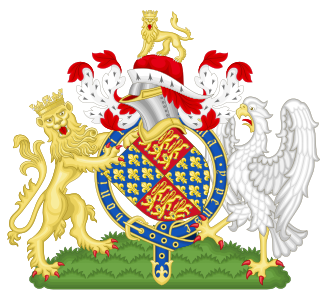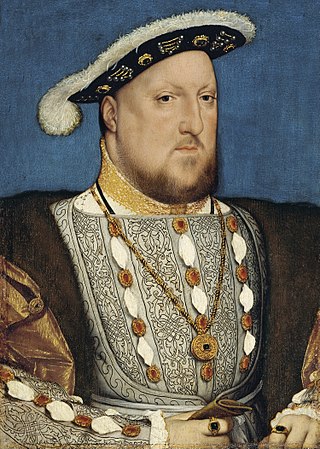
Mary I, also known as Mary Tudor, and as "Bloody Mary" by her Protestant opponents, was Queen of England and Ireland from July 1553 and Queen of Spain as the wife of King Philip II from January 1556 until her death in 1558. She is best known for her vigorous attempt to reverse the English Reformation, which had begun during the reign of her father, King Henry VIII. Her attempt to restore to the Church the property confiscated in the previous two reigns was largely thwarted by Parliament, but during her five-year reign, Mary had over 280 religious dissenters burned at the stake in the Marian persecutions.

Titulus Regius is a statute of the Parliament of England issued in 1484 by which the title of King of England was given to Richard III.

Reginald Pole was an English cardinal and the last Catholic archbishop of Canterbury, holding the office from 1556 to 1558, during the Counter-Reformation.
In English history, the penal laws were a series of laws that sought to uphold the establishment and State decreed religious monopoly of the Church of England against illegal and underground Catholics and Protestant nonconformists by imposing various forfeitures, civil penalties, and civil disabilities upon recusants from mandatory attendance at weekly Anglican Sunday services. The penal laws in general were repealed in the early 19th century during the process of Catholic Emancipation. Penal actions are civil in nature and were not English common law.
The Acts of Supremacy are two acts passed by the Parliament of England in the 16th century that established the English monarchs as the head of the Church of England; two similar laws were passed by the Parliament of Ireland establishing the English monarchs as the head of the Church of Ireland. The 1534 Act declared King Henry VIII and his successors as the Supreme Head of the Church, replacing the Pope. This first Act was repealed during the reign of the Catholic Queen Mary I. The 1558 Act declared Queen Elizabeth I and her successors the Supreme Governor of the Church, a title that the British monarch still holds.
Thomas Watson was a Catholic Bishop, notable among Catholics for his descriptions of the Protestant Reformation. Historian Albert Pollard described Watson as "one of the chief Catholic controversialists" of Mary Tudor's reign.

The Act of Supremacy 1558, sometimes referred to as the Act of Supremacy 1559, is an Act of the Parliament of England, which replaced the original Act of Supremacy 1534, and passed under the auspices of Elizabeth I. The 1534 Act was issued by Elizabeth's father, Henry VIII, which arrogated ecclesiastical authority to the monarchy, but which had been repealed by Mary I. Along with the Act of Uniformity 1558, the Act made up what is generally referred to as the Elizabethan Religious Settlement.

De heretico comburendo or the Suppression of Heresy Act 1400 was a law passed by Parliament under King Henry IV of England in 1401 for the suppression of the Lollards. It punished seditious heretics with burning at the stake. This law was one of the strictest religious censorship statutes ever enacted in England, affecting preaching and possession of Lollard literature.

The Second Statute of Repeal or the See of Rome Act 1554, was an act of the Parliament of England passed in the Parliament of Queen Mary I and King Philip in 1555, followed the First Statute of Repeal of 1553. The first statute had abolished all religious legislation passed under Edward VI and the second statute built on it by abolishing all religious legislation passed against the papacy from 1529 in Henry VIII's reign. It did this while allowing Mary to keep the title of Supreme Head of the Church of England, a title which had been given to the monarch of England by Henry VIII's Act of Supremacy, passed in 1534. It was supported by the landed classes as it allowed them to keep the monastic land which they had acquired after the dissolution of the monasteries.

The First Statute of Repeal was an Act of the Parliament of England, passed in 1553 in the first Parliament of Mary I's reign, nullified all religious legislation passed under the previous monarch, the boy-king Edward VI, and the de facto rulers of that time, Edward Seymour, 1st Duke of Somerset, and John Dudley, 1st Duke of Northumberland.
The English Protestant Reformation was imposed by the English Crown, and submission to its essential points was exacted by the State with post-Reformation oaths. With some solemnity, by oath, test, or formal declaration, English churchmen and others were required to assent to the religious changes, starting in the sixteenth century and continuing for more than 250 years.

The English Reformation took place in 16th-century England when the Church of England broke away from the authority of the pope and the Catholic Church. These events were part of the wider European Reformation, a religious and political movement that affected the practice of Christianity in Western and Central Europe.

The Treason Act 1554 was an Act of the Parliament of England. It is not to be confused with two other Acts about treason passed in the same year, 1 & 2 Ph. & M. cc. 9 and 11.

The Treason Act 1547 was an Act of the Parliament of England. It is mainly notable for being the first instance of the rule that two witnesses are needed to prove a charge of treason, a rule which still exists today in the United States Constitution.

The Treason Act 1397 was an Act of the Parliament of England. It was supplemented by six other Acts. The seven Acts together dealt with high treason.

The Statute of Gloucester is a piece of legislation enacted in the Parliament of England during the reign of Edward I. The statute, proclaimed at Gloucester in August 1278, was crucial to the development of English law. The Statute of Gloucester and the ensuing legal hearings were a means by which Edward I tried to recover regal authority that had been alienated during the reign of his father, King Henry III (1207–1272), who had been made a virtual tool of the baronial party, led by Simon de Montfort. Edward I recognized the need for the legal "reform" and considered Parliament as a means of buying popular support by encouraging loyal subjects to petition the King against his own barons and ministers.
The Reformation in Ireland was a movement for the reform of religious life and institutions that was introduced into Ireland by the English administration at the behest of King Henry VIII of England. His desire for an annulment of his marriage was known as the King's Great Matter. Ultimately Pope Clement VII refused the petition; consequently, in order to give legal effect to his wishes, it became necessary for the King to assert his lordship over the Catholic Church in his realm. In passing the Acts of Supremacy in 1534, the English Parliament confirmed the King's supremacy over the Church in the Kingdom of England. This challenge to Papal supremacy resulted in a breach with the Catholic Church. By 1541, the Irish Parliament had agreed to the change in status of the country from that of a Lordship to that of Kingdom of Ireland.
The regnal years of English and British monarchs are the official regnal years of the monarchs of the Kingdom of England from 1066, the Kingdom of Great Britain from May 1707 to January 1801, and the United Kingdom since January 1801. The regnal calendar continues to be used in many official British government and legal documents of historical interest, notably parliamentary statutes.

The Egyptians Act 1554 is a piece of 16th-century English legislation regarding Romani and travelers within the realm. The act was passed to amend previous laws regarding the Romani people. The Egyptians Act 1530 did not cover Gypsies who were born in England or those who came to England by way of Scotland.










